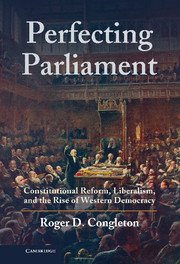Book contents
- Frontmatter
- Contents
- Preface
- 1 On the Origins of Western Democracy
- Part I Sharing Sovereignty
- Part II Historical Evidence on Western Democratic Transitions
- 9 Setting the Stage
- 10 Liberalism and Reform in the Transformative Century
- 11 Fine-Grained Constitutional Bargaining
- 12 An Overview of British Constitutional History
- 13 Constitutional Exchange in the United Kingdom
- 14 The Swedish Transition to Democracy
- 15 Constitutional Reform in the Netherlands
- 16 Germany
- 17 The Japanese Transition to Democracy and Back
- 18 The United States, an Exception or Further Illustration?
- Part III Analytical History as Social Science
- Appendix Methodological Approach, Limits, and Extensions
- References
- Index
17 - The Japanese Transition to Democracy and Back
Published online by Cambridge University Press: 05 June 2012
- Frontmatter
- Contents
- Preface
- 1 On the Origins of Western Democracy
- Part I Sharing Sovereignty
- Part II Historical Evidence on Western Democratic Transitions
- 9 Setting the Stage
- 10 Liberalism and Reform in the Transformative Century
- 11 Fine-Grained Constitutional Bargaining
- 12 An Overview of British Constitutional History
- 13 Constitutional Exchange in the United Kingdom
- 14 The Swedish Transition to Democracy
- 15 Constitutional Reform in the Netherlands
- 16 Germany
- 17 The Japanese Transition to Democracy and Back
- 18 The United States, an Exception or Further Illustration?
- Part III Analytical History as Social Science
- Appendix Methodological Approach, Limits, and Extensions
- References
- Index
Summary
INTRODUCTION
The first four case studies might lead readers to conclude that there was something unique about European culture that made it “ready” for parliamentary democracy in 1820. The king-and-council template had long been used for European governance and provided numerous opportunities for peaceful constitutional reform. Liberalism can be regarded as the political reform agenda of the enlightenment, a European intellectual development. Many of the most important technological innovations of the eighteenth and nineteenth centuries were worked out in Europe. Overall, it might be argued that European ideas and institutions made Europe uniquely ready to shift from autocracy to democracy without revolution.
The theory developed in Part I is, however, not a theory of European transitions. It suggests that similar ideas and opportunities for constitutional bargaining will exist in other societies in which broadly similar institutions are in place and trends in constitutional-bargaining opportunities favor liberal reforms. The last two case studies demonstrate that the European transitions were not unique.
- Type
- Chapter
- Information
- Perfecting ParliamentConstitutional Reform, Liberalism, and the Rise of Western Democracy, pp. 485 - 521Publisher: Cambridge University PressPrint publication year: 2010



